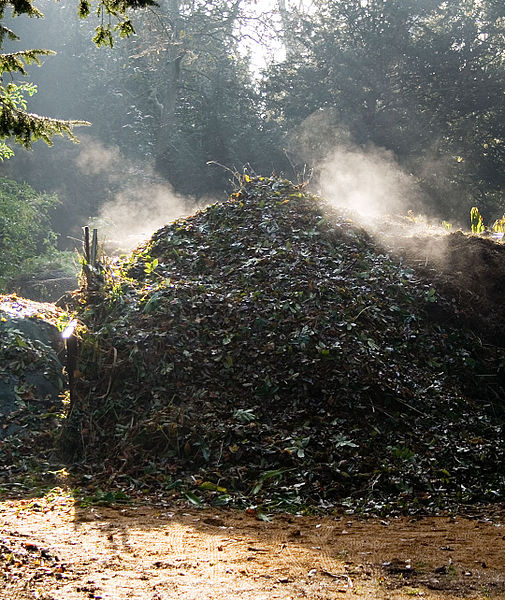As long as there have been humans, we have taken the parts of plants we don’t eat and thrown them back onto the soil again, knowing it would turn back into soil to create more plants. Until we modern people came along, that is.
Now we take our food and seal it away in plastic, so that the only bacteria that can work on them are anoxic bacteria that generate methane – a greenhouse gas about 35 times worse than carbon dioxide. The least we can do, obviously, is to throw compostables into the compost, let the proper critters munch away, and let it alchemically turn into soil again.
Ordinary composting, however, has some disadvantages that every gardener knows well. One can’t simply add bones or meat – and some gardeners even avoid eggshells – for fear of attracting vermin. Also, plants that have gone to seed cannot be added, or the resulting soil will be peppered with the beginning of next year’s weeds. You can’t add diseased plants, or the diseases might remain in the resulting soil, ready to infect next year’s crops. Also, it takes a long time, and one loses much of the kitchen waste volume in the process of rotting down.
Imagine, then, a new kind of composting, one that avoids all these problems at once – no more weed seeds, no more disease, no more vermin. Imagine being able to compost almost everything, and keep the majority of the biomass. Imagine, finally, that it only takes a few weeks.
What makes hot composting work is bacteria; instead of the usual variety of bacteria that breaks down over several months, hot composters find the right balance of materials – more on this in a moment — to attract aerobic, heat-generating bacteria. Then, they oxygenate the soil by turning the compost regularly, and making sure the compost has enough mass – at least 1.5 metres on each side — to retain the heat it generates.
The bacteria generate heat just as your body does — between 55 and 65 degrees Centigrade, hot enough to kill any weed seeds and diseases, hot enough to drive away most vermin, and hot enough to feed their fast action.
With this so-called Berkeley method, you first fill a container of the appropriate size with kitchen waste – that’s a lot of waste at once, so you might want to get all your neighbours’ materials together in a communal bin. Leave the compost for four days with no turning.
Then, turn the compost every second day for the next 14 days, making sure to turn it thoroughly from the outside in to get everything well mixed. By the 18th day, it should look like soil – but you still need to let it rest for several more weeks before planting in it.
I mentioned the right balance of materials to compost; the ratio one looks for is between 25 and 30 parts carbon-rich waste to one part nitrogen-rich waste, proportioned by weight. Carbon-rich materials are typically dry and brown, like sawdust, cardboard, paper, dried leaves, straw and other, similar things. Nitrogen-rich materials are typically moist and fresh, like kitchen waste, lawn clippings and vegetable scraps. Sometimes carbon-rich materials are called “browns” and nitrogen-rich materials “greens” for simplicity, but these terms can be misleading: coffee grounds and animal manure, whatever their colour, would also be nitrogen-rich.
If the carbon/nitrogen ratio is too high in carbon, the compost will not get hot enough or break down quickly enough, and one must add something like manure or grass clippings. If the mix has too much nitrogen, rather smelly bacteria will take over, and the mix might get slimy.
To get the right C/N ratio, keep in mind that all plants have more carbon than nitrogen, so virtually all materials have a ratio of at least 1/1. “Browns” like wood chips have a ratio of 400/1, newspaper has 175/1, and straw has 75/1. “Greens” like vegetable scraps have about 25/1, grass clippings 20/1, and chicken manure has about 12/1. Urine has a ratio of about 1/1, and is excellent to add to soil in whatever way does not violate your social anxieties or local ordinances.
Not everyone can use this method; while I have learned about this and seen it work, our household does not generate enough waste alone; an entire suburb, however, could incorporate the refuse from nearby grocery stores, lawn clippings, mulch and other compostables into the mix, and make this work.
Composting this way eliminates the harmful greenhouse gases that most of our food waste emits, cutting back on climate change. It also generates heat that some people can use to heat their homes or water supply – I’ve seen a functional and quite comfortable outdoor shower in County Tipperary, powered entirely by the bacterial heat of a hot compost bin.
Households in Minnesota, where I used to live, could spend perhaps $2,000 a year on heating. Imagine homes with hot composters attached, which can use their heat — perhaps in conjunction with an attached greenhouse. Such simple innovations, if handled rightly by the households, would turn their waste into soil quickly at a time when we need more soil to plant in. It would cut their emissions from garbage and at the same time cut their emissions from fossil fuels, since they would not have to burn as much gas or oil. It would reduce their debt, and their dependence on govenrment and corporations, all at the same time. Few inventions could have more of an impact on our society, if widely implemented.
Photo: Compost heap on a frosty morning. The rising steam shows that the bacterial action in the compost heap is exothermic. (2005). © Andrew Dunn. Via Wikimedia Commons https://commons.wikimedia.org/wiki/File:Compost_Heap.jpg






